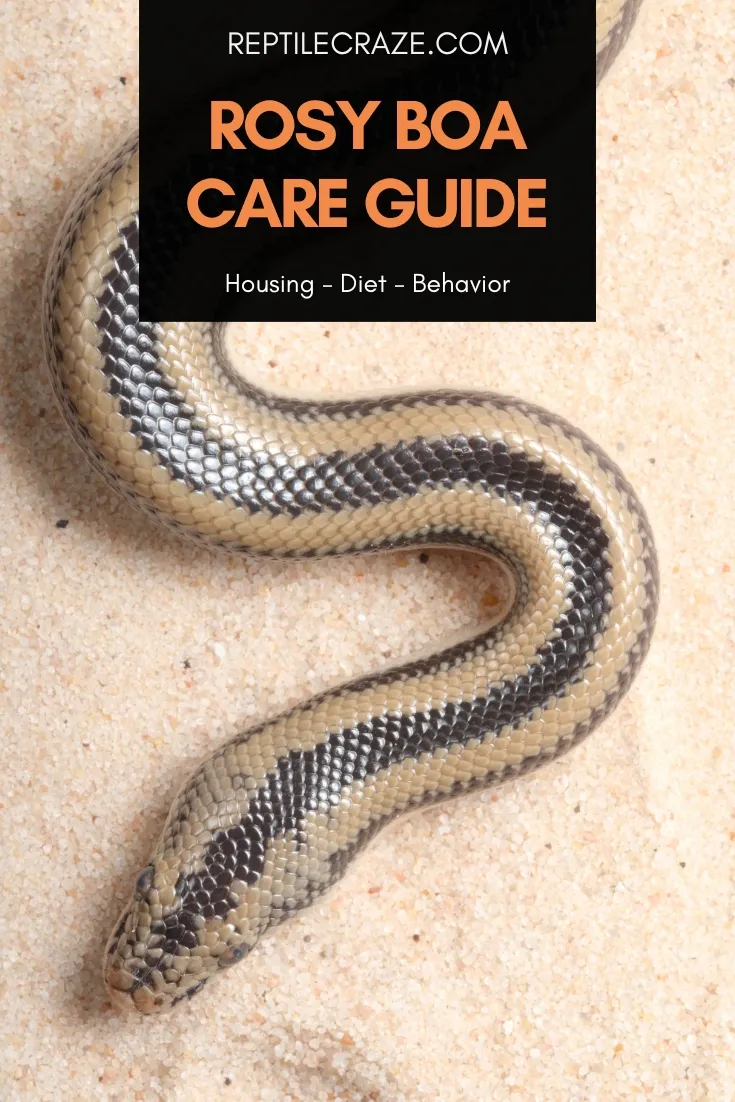
Even though Ball Pythons are undoubtedly the most popular pet snake, Rosy Boas have become increasingly popular.
These undemanding snakes are an excellent option for novices, but even experienced owners can enjoy their unobtrusive presence, lovely temperament, and numerous available morphs.
This article aims to show you the advantages and downsides of keeping a friendly and docile Rosy Boa as a pet with low husbandry requirements.
Table of Contents
Rosy Boa Facts
| Scientific name | 1 Lichanura trivirgata 2 Lichanura orcutti |
| Common name | 1 Desert Rosy Boa 2 Coastal Rosy Boa (Northern Three-lined Boa) |
| Adult size | Desert Boa females – 17 to 36 inches (43 – 91.50 cm) Coastal Rosy Boa – 24 to 44 inches (61 – 112 cm) Males are slightly shorter than females |
| Adult weight | 0.22 to 0.88 pounds (100 – 400 g) |
| Lifespan | 25 to 30 years |
| Natural habitat | Arid scrublands, rocky crevices, canyons, and desert regions |
| Enclosure size | A |
| Daytime temperature | Cool zone 72 to 80 F (22 – 27 C) Basking spot 85 to 95 F (29.50 – 35 C) |
| Night-time temperature | 68 to 72 F (20 – 22 C) with a min of 60 F (15.50 C) |
| Humidity | 20 to 40%, with a max of 60% during a shedding period |
| Diet | Carnivorous that can consume the rat, gerbil, hamster, and quail youngs, amphibians, small lizards, chicks, quail eggs, and Reptilinks |
| Experience level | Beginners |
Where do Rosy Boas live?
The Desert Rosy Boa is native to the American Southwest and the Republic of Sonora, Mexico. On the other hand, you can find the Coastal Rosy Boa species on the US – Mexico border.
Both species are endemic, and their habitat includes arid scrublands, rocky crevices, desert regions, and canyons.
Rosy Boa appearance, colors, and morphs
Rosy Boas’ appearance significantly varies, and the combination of color and pattern always depends on the snake’s habitat. You can quickly conclude where the snake you look at came from based on the color of its skin and specific pattern.
Coastal Rosy Boas – These snakes come with a typical three orange, tan, reddish-brown, or brick-red stripes along the body. They alternate with white, blue-grey, or yellow interspaces.
Desert Rosy Boas – You can recognize these snakes thanks to three longitudinal stripes and a rosy or salmon-colored lower body side.
Females are slightly more sizable than males, but their anal spurs are less developed.
Rosy Boas are increasingly popular pets in the US and worldwide because of their attractive colors, besides other positive traits.
Despite numerous variations present in the wild, breeders give their best to develop new and unique morphs.
The most popular captive genetic morphs are:
- Albino Borrego Rosy Boa
- Snowwhite Snow Rosy Boa
- Anerythristic Rosy Boa
- Hypo Borrego Rosy Boa
- Smith Snow Rosy Boa
White and gray-blue snake variations with powder-blue eyes are currently the most sought-after among owners.
How big do Rosy Boas get?
As mentioned, you can choose one of two Rosy Boa variations. Smaller Desert Boas typically grow up to 17 to 36 inches (43 – 91.50 cm), while Coastal Rosy Boas are a bit longer.
Their average length is 24 to 44 inches (61 – 112 cm). Males are always slightly shorter than females, regardless of the type, but both weigh about 1 to 3 pounds (0.45 – 1.36 kg) on average.
| Age | Female length and weight |
| Juveniles | 10 to 12 inches (25.50 – 30.50 cm) 0.02 pounds (10 g) |
| Adults | 17 to 44 inches (43 – 112 cm) 1 to 3 pounds (0.45 – 1.36 kg) |
Rosy Boas are really tiny when they are born. Hatchlings’ standard length is 10 to 12 inches (25.50 – 30.50 cm), and they weigh only 0.02 pounds (10 g).
Rosy Boa lifespan
Rosy Boas are long-lived reptiles with an average lifespan of two to three decades. Still, these snakes can live even longer when provided living conditions are excellent, and they get the proper care.
It is pretty common to expect your pet to live 20 or 35 years, but even that is not the limit. One Rosy Boa reached a surprising record after living over 60 years.
How to Care for Rosy Boas?
Rosy Boas are undemanding snakes satisfied with small spaces, some
Rosy Boa tank setup
Most experts and owners recommend a
| Rosy Boa size | Ideal | Tank size |
| 24 inches (61 cm) | 12 by 24 by 12 inches (30.50 x 61 x 30.50 cm) | 10 to 15 gallons (38 – 57 l) |
| 24 to 36 inches (61 – 91.50 cm) | 12 by 36 by 12 inches (30.50 x 91.50 x 30.50 cm) | 20 to 30 gallons (76 – 113.50 l) |
| 36 inches (91.50 cm) | 18 by 36 by 18 inches (46 x 91.50 x 46 cm) | Front-opening terrarium of 50 gallons (190 l) |
| 44 inches (112 cm) | 24 x 48 x 24 inches (61 x 122 x 61 cm) | 120 gallons (454 l) |
Despite that, the formula that determines a minimum space for a snake, depending on its length, is clear. You should provide a terrarium long as your pet, while its height and width should equal half snake length.
In other words, your Desert Boa, with an average length of 17 to 36 inches (43 – 91.50 cm), requires a 50-gallon
Since Coastal Rosy Boa females often reach 24 to 44 inches (61 – 112 cm), they will feel super comfortable in a terrarium of up to 120 gallons (454 l).
Lighting and temperature
Rosy boas change activity level during 24 hours, depending on the season.
For instance, they are primarily nocturnal animals during the summer but become diurnal in the spring and autumn when the temperatures are moderate.
They brumate during winter. Therefore, you should provide adequate lighting for each period of the year but avoid being too intense.
Be aware that brumation is not strictly necessary in captivity, and you can prevent it by temperature and light regulation.
The temperature level is one of the crucial issues when organizing the terrarium for your Rosy Boa. These snakes are highly sensitive to significant temperature deviations and cold environments.
The best to do is to install a thermostat, providing a
The average night-time temperature is from 68 to 72 F (20 – 22 C), and you should always keep it from dropping below 60 F (15.50 C).
Remember to provide higher temperatures during shedding and raising hatchlings and keep it low during the brumation period.
If you notice your Rosy Boa is disturbed and restlessly moves, it is a sign that the temperature inside the
Do Rosy Boas need UVB?
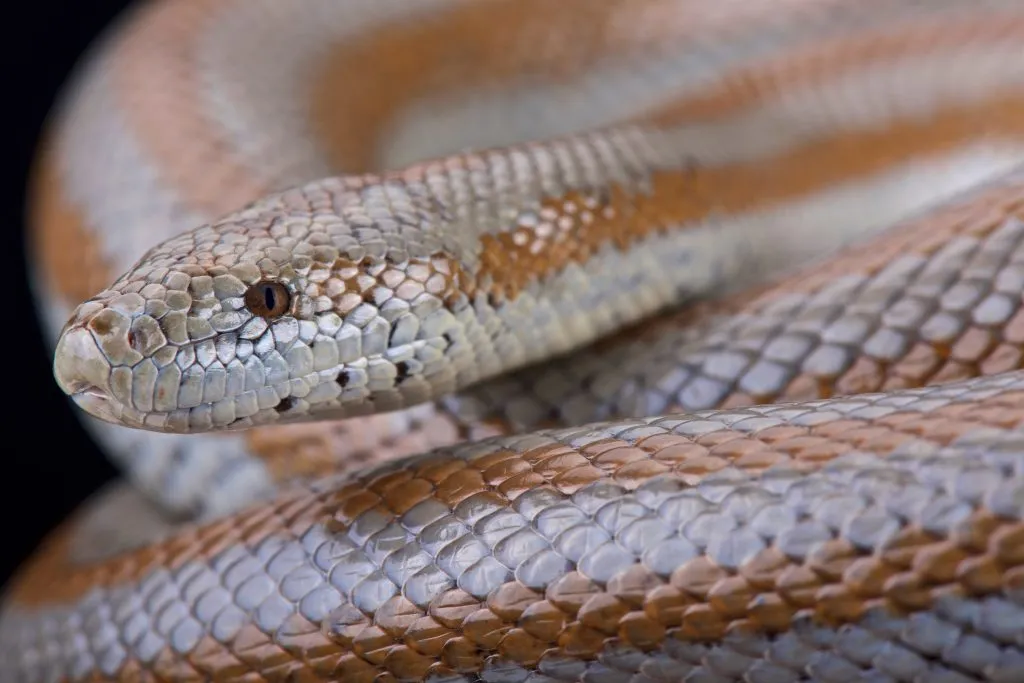
Rosy Boas can survive without UVB lighting, but most owners prefer adding it to their pets’ terrariums. It provides a regular day/night cycle that positively affects snakes’ health, including:
- Improving the immune system
- Facilitating digestion
- Providing enough vitamin D
You can get the best result when putting the lamp 10 to 13 inches (25.40 – 33 cm) above the basking surface next to the heat lamp.
Keep the light on about 10 hours daily in winter and at least 14 hours a day during the summer. Take care to replace the bulb once or twice a year, depending on the model.
Humidity
Rosy Boas are oversensitive to high humidity, so keep it between 20 and 40%. However, increasing this level to 60% during the shedding period is necessary to make it easier for your snake to change its skin.
Remember that a humidity level of over 50% during a prolonged period can lead to respiratory infections. Balance it by vent regulating and keeping the room temperature at a required level.
Substrate
Most owners buy tanks with a solid base or a false bottom, allowing urine and feces through. When made of glass, it is vital to add substrate making the enclosure more comfortable and dry.
The recommended substrate options include paper towels with an additional layer of absorbent materials approximately 3 to 4 inches (7.62 – 10.16 cm) thick. You should choose materials like:
- Cypress shavings
- Aspen shavings
Avoid adding aromatic woods like cedar and pine in the
Other good options include:
- Sandy soil
- Colored sand designed for reptiles
- Sand
- DIY substrate made of 60% additive-free organic topsoil and 40% sand
- Commercial mixes, like Exo Terra desert sand, Zoo Med ReptiSand, and Zoo Med Aspen snake bedding
Placing an insulating layer, such as a reptile carpet and felt, under the heating area is practical. Unfortunately, such a rough surface can irritate your tender pet.
Check the substrate daily, clean it regularly, and completely change it once in two to three months, depending on the
Rosy Boa tank decor
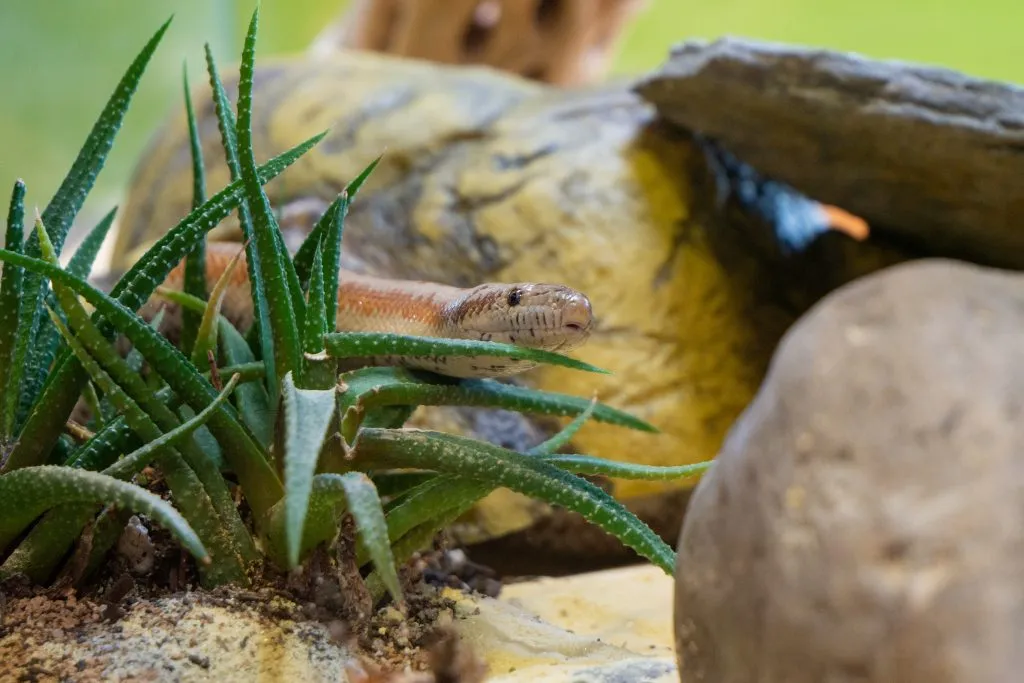
Tank decor is vital for Rosy Boas since various accessories encourage them to move, exercise, and find a place to hide. The best options are:
- Artificial caves, ledges, burrows, and hideouts
- Sturdy branches
- Cork flats, tubes, and logs
- Pieces made of cholla and ghost wood
- Artificial and drought-tolerant live plants
- Paver stones and rocks
It is vital to provide enough hiding places in both warm and cool
How to clean a Rosy Boa tank
Besides proper diet, regular
Remove approximately 1 inch (2.54 cm) of the top bedding weekly and replace it with a layer of fresh substrate. The enclosure requires deep cleaning at least once a month.
Monthly cleaning includes spraying the
Then, wash all pieces in soapy water and thoroughly rinse and dry them before returning them to the
Rosy Boa diet
Rosy Boas are humble snakes that never require an excessively varied and abundant diet. Depending on their age, they are happy with a moderate meal once a week or so and periodically need a period without
What to feed
Rosy boas enjoy eating mice, making this readily available
- Young rats, gerbils, hamsters, and quails
- Rabbit pinkies
- African soft-furred rat babies
- Lizards, like Skinks, Green Anoles, and Geckos
- Chicks
- Amphibians
- Quail eggs
- Reptilinks
How often to feed
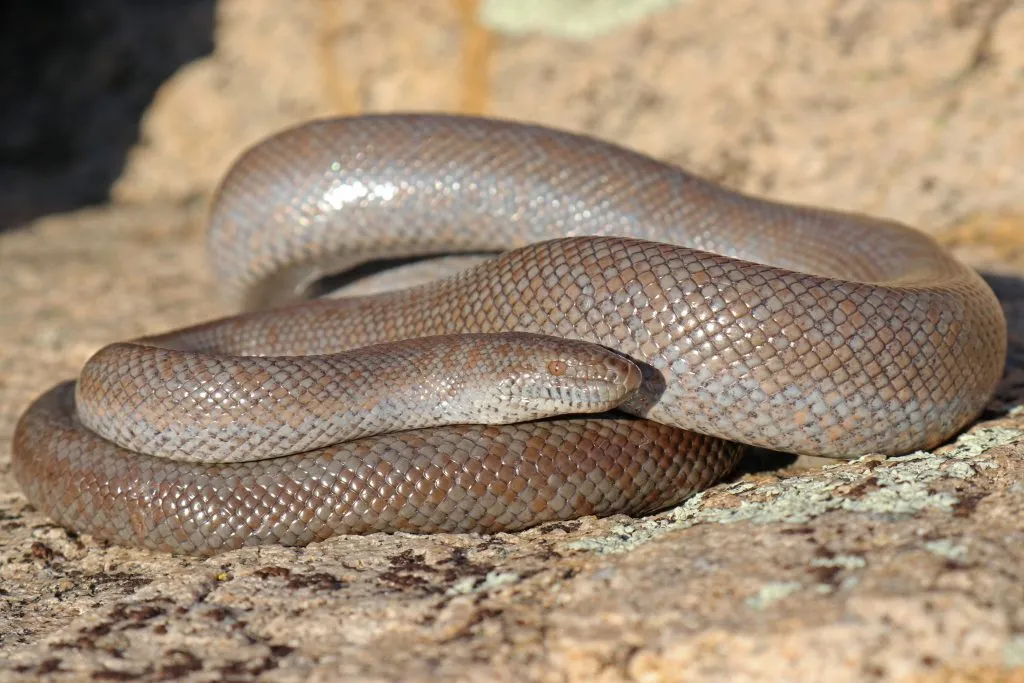
Offering pinkie mice to your Rosy Boas hatchling is excellent, but you should switch to fuzzy mice once your snake is six months old.
It typically eats once a week, while the adult snake feeding schedule includes one medium mouse once in 10 to 14 days.
| Rosy Boa age | Feeding schedule |
| The first six months | A pinkie mouse once in a 5 to 7 days |
| 6 to 18 months | A fuzzy mouse once a week |
| 18 months to three years | A hopper mouse once a week |
| Over three years | A medium mouse once in 10 to 14 days |
How long can they go without food ?
Rosy Boas are remarkable snakes that can survive 3 to 4 months without
Do Rosy Boas need water?
Since Rosy Boas are desert species, they don’t need continual access to water. You can offer your snake a bowl of water once a week or even a month, but never immediately after feeding.
Otherwise, it will regurgitate ingested
Vitamins and minerals
A healthy Rosy boa doesn’t need vitamin and mineral supplementation. However, you can introduce light prey dusting with a calcium and multivitamin solution in a 50%: 50% ratio from time to time.
Rosy Boa Behavior and Temperament
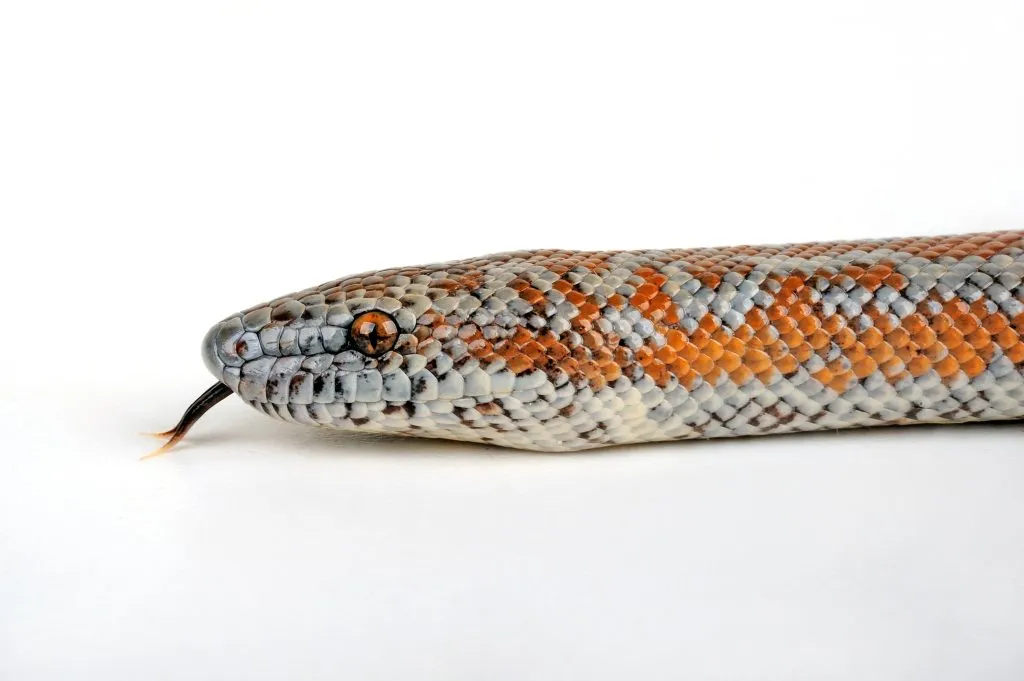
Rosy Boas are calm, even-tempered snakes ideal for beginners and insecure owners. They require gentle handling and enjoy slowly roaming along your hands.
Support your pet with both hands when needed, and avoid restraining it.
You can expect this snake to try to escape from your arms when feeling uncomfortable. It can sometimes use mild defensive bites to warn you to loosen your grip and be gentler.
Once it relaxes, you can be sure it feels safe and unthreatened.
Are Rosy Boas Good Pets?
The Rosy Boa should be the most popular pet snake based on its behavior and needs. They have an appealing temperament, behave friendly, and have no complicated
Once you bring this reptile home, you should let it get used to the new habitat for about two weeks. Then, it is time to gradually start handling it for approximately five minutes daily until calm and relaxed.
When it accepts you, it is OK to prolonged socializing. Never pause for more than a week without contact, nor handle your snake more than once a day.
Rosy Boa Common Health Problems
Rosy Boas are hardy, undemanding snake species. There is no reason to worry as long as your pet is calm and docile, eats regularly, and has a required excretion ratio. The most common health issues it can suffer from include:
- Bacterial dermatitis
- Stuck sheds
- Respiratory disease
- Scale and mouth rot
- Stomatitis
- Internal parasites (worms)
- Ticks and mites
Where to buy Rosy Boas?
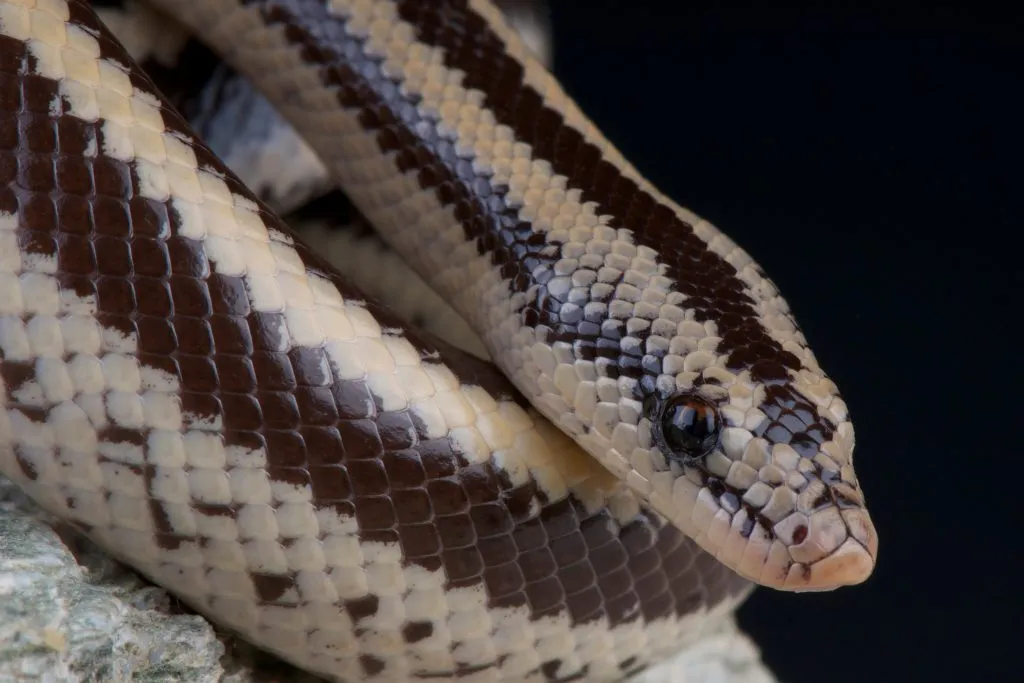
You can find Rosy Boas at various places providing exotic pets, like:
- Reptile specialty stores
- HERPS exotic reptile and pet show
- Private online reptile shops
However, the best option is to order the snake from the most reputable breeders to be sure that the Rosy Boa you get is healthy and without hereditary anomalies. You can visit one of the stores with high scores, such as:
- Golden West Reptiles from California
- Prehistoric Pets from California
- Absolutely Reptacular from New York
- Gopher Your Pet from Texas
- SKB Exotics from Washington
Rosy Boa price
Rosy Boas are increasing in popularity, but finding one is often challenging.
Even though they are not endangered species, buying wild snakes is not recommended because it can negatively affect wild populations.
Additionally, you should know basic data about your pet, like age, feeding habits, and temperament.
An average juvenile Rosy Boa costs about $25, but locality-specific snakes are always more expensive. In most cases, you should set aside approximately $75 to $100 for one bred in captivity.
Snakes with unique locality colorations can cost approximately $200, while some morphs are even more expensive. For instance, the price of albino Rosy Boas is about $300.
- Eastern Rat Snake: Nature’s Pest Control and Fascinating Reptile - September 20, 2024
- Eastern Racer: The Fast and Agile Snake - September 19, 2024
- The Eastern Indigo Snake: The Majestic, Non-Venomous Hunter of the Southeast - September 18, 2024
